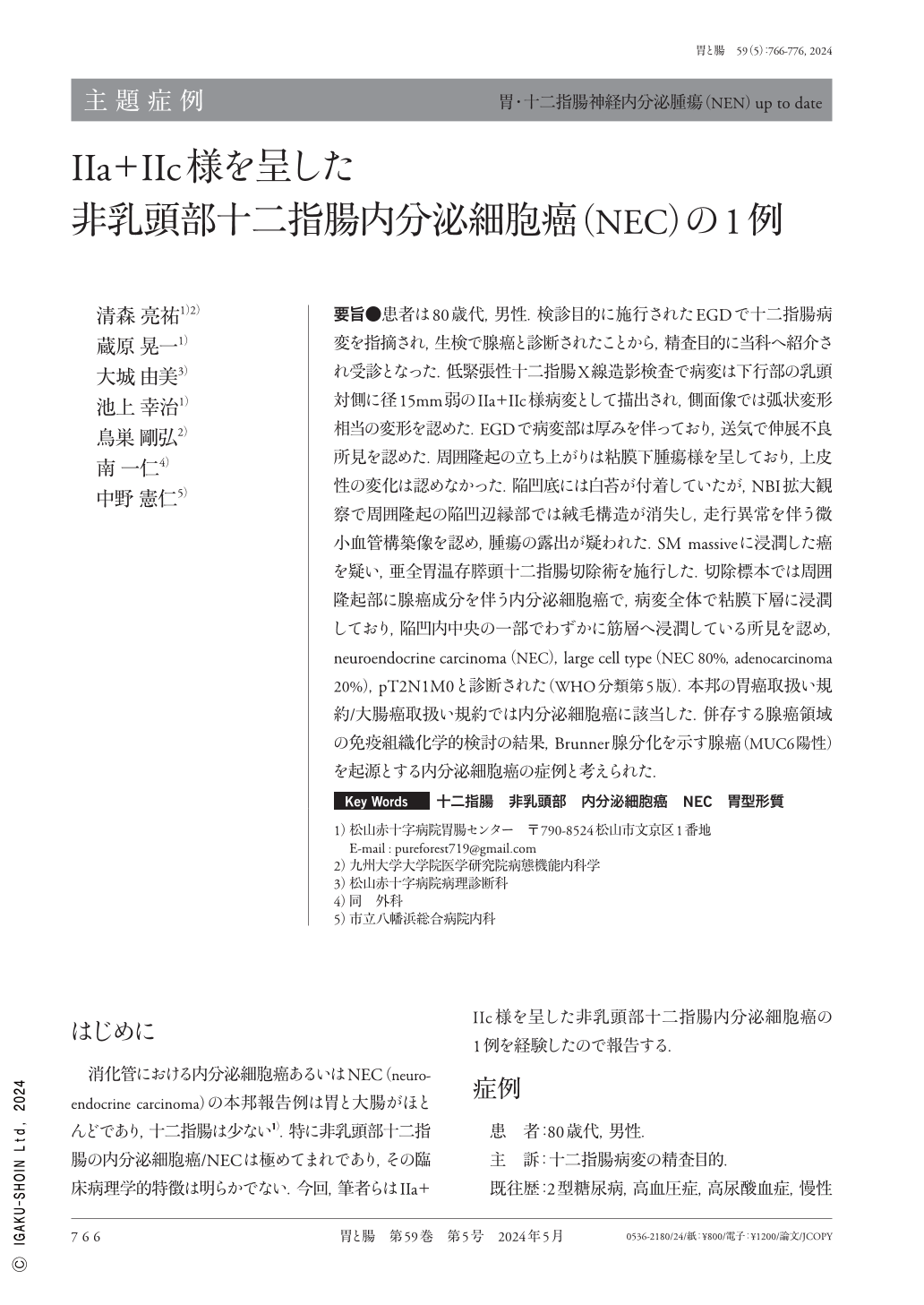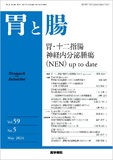Japanese
English
- 有料閲覧
- Abstract 文献概要
- 1ページ目 Look Inside
- 参考文献 Reference
要旨●患者は80歳代,男性.検診目的に施行されたEGDで十二指腸病変を指摘され,生検で腺癌と診断されたことから,精査目的に当科へ紹介され受診となった.低緊張性十二指腸X線造影検査で病変は下行部の乳頭対側に径15mm弱のIIa+IIc様病変として描出され,側面像では弧状変形相当の変形を認めた.EGDで病変部は厚みを伴っており,送気で伸展不良所見を認めた.周囲隆起の立ち上がりは粘膜下腫瘍様を呈しており,上皮性の変化は認めなかった.陥凹底には白苔が付着していたが,NBI拡大観察で周囲隆起の陥凹辺縁部では絨毛構造が消失し,走行異常を伴う微小血管構築像を認め,腫瘍の露出が疑われた.SM massiveに浸潤した癌を疑い,亜全胃温存膵頭十二指腸切除術を施行した.切除標本では周囲隆起部に腺癌成分を伴う内分泌細胞癌で,病変全体で粘膜下層に浸潤しており,陥凹内中央の一部でわずかに筋層へ浸潤している所見を認め,neuroendocrine carcinoma(NEC),large cell type(NEC 80%,adenocarcinoma 20%),pT2N1M0と診断された(WHO分類第5版).本邦の胃癌取扱い規約/大腸癌取扱い規約では内分泌細胞癌に該当した.併存する腺癌領域の免疫組織化学的検討の結果,Brunner腺分化を示す腺癌(MUC6陽性)を起源とする内分泌細胞癌の症例と考えられた.
A male patient in his 80s underwent upper gastrointestinal endoscopy and was found to have duodenal lesions. He was diagnosed with adenocarcinoma based on a biopsy and was referred to our department for further examination. Hypotonic duodenography revealed an IIa+IIc like lesion <15mm in diameter in the contralateral papillary area of the descending segment. Lateral view of the lesions indicated an arch-shaped deformity. Upper gastrointestinal endoscopy revealed thick lesions and poor extension when air was fed. The areas surrounding the lesions presented submucosal tumor-like elevations without epithelial alterations. Although slough was present at the lesion's depressed base, narrow band imaging and magnified endoscopy indicated orientation-related microvascular anomalies and the disappearance of villus architecture in the margins of the elevated site around the lesion's depressions, suggesting tumor exposure. Suspected of SM-massive cancer, subtotal stomach-preserving pancreaticoduodenectomy was performed. The resected specimen presented findings of endocrine cell carcinoma with an adenocarcinoma component in the elevated area around the lesions, infiltrating into the submucosal layer of the lesions and a slight infiltration into the muscular layer of the central depressed area. Consequently, the patient was diagnosed with neuroendocrine carcinoma, large cell type(neuroendocrine cell carcinoma 80%, adenocarcinoma 20%), pT2N1M0(WHO classification, 5th ed.). According to the cancer classification in Japan, it is classified as endocrine cell carcinoma.Moreover, based on the result of an immunohistochemical examination performed on a concomitant adenocarcinoma, the patient was considered to have endocrine cell carcinoma arising from adenocarcinoma of Brunner's gland(MUC6 positive).

Copyright © 2024, Igaku-Shoin Ltd. All rights reserved.


